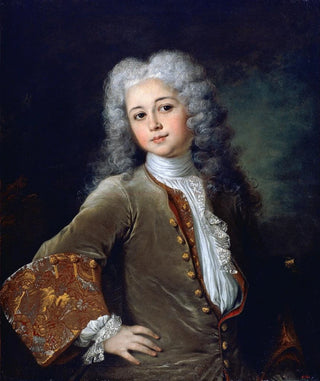Taidetuloste | Portrait of a young man with a wig - Nicolas de Largillière


Takaa näkyvä näkymä

Kehys (valinnainen)
Reproduction Portrait of a Young Man with a Wig - Nicolas de Largillière – Captivating Introduction
French baroque art's fascinating universe features Nicolas de Largillière's "Portrait of a Young Man with a Wig," distinguished by its elegance and psychological depth. This iconic taidetuloste, painted in the early 18th century, embodies not only the exceptional talent of its creator but also the refined aesthetics of an era when a portrait became a means of asserting social status and personality. Through this taidetuloste, the viewer is invited to immerse themselves in a world where every detail, every brushstroke, tells a story—the story of a young man whose gaze seems to pierce through time.
Style and uniqueness of the work
Largillière's style is characterized by a remarkable mastery of light and shadow, which gives his taidetuloste an almost lifelike dimension. In this work, the carefully coiffed wig of the young man, a symbol of the elegance of his time, is rendered with precision that highlights the texture of the hair. The choice of colors, ranging from warm tones to cooler shades, creates a striking contrast that immediately captures the eye. The meticulous details, such as reflections on the fabric of the jacket, testify to a concern for realism and a particular attention to the representation of fashion of his time. Largillière thus manages to capture not only the physical appearance of his model but also a certain essence of their personality, making this portrait timeless and universal.
The artist and his influence
Nicolas de Largillière, born in 1656, is considered one of the most important portraitists of his era. Trained at the Flemish school, he skillfully combined influences from northern Europe with French trends, creating a unique style that appealed to the elites of his time. Largillière had the honor of painting many influential personalities, from nobles to court members, which allowed him to establish himself in the Parisian artistic scene. His innovative approach to portraiture, blending realism and idealization, inspired many artists who succeeded him, contributing to the genre's evolution. Through his works, he not only documented an era, but

Rendu mat

Takaa näkyvä näkymä

Kehys (valinnainen)
Reproduction Portrait of a Young Man with a Wig - Nicolas de Largillière – Captivating Introduction
French baroque art's fascinating universe features Nicolas de Largillière's "Portrait of a Young Man with a Wig," distinguished by its elegance and psychological depth. This iconic taidetuloste, painted in the early 18th century, embodies not only the exceptional talent of its creator but also the refined aesthetics of an era when a portrait became a means of asserting social status and personality. Through this taidetuloste, the viewer is invited to immerse themselves in a world where every detail, every brushstroke, tells a story—the story of a young man whose gaze seems to pierce through time.
Style and uniqueness of the work
Largillière's style is characterized by a remarkable mastery of light and shadow, which gives his taidetuloste an almost lifelike dimension. In this work, the carefully coiffed wig of the young man, a symbol of the elegance of his time, is rendered with precision that highlights the texture of the hair. The choice of colors, ranging from warm tones to cooler shades, creates a striking contrast that immediately captures the eye. The meticulous details, such as reflections on the fabric of the jacket, testify to a concern for realism and a particular attention to the representation of fashion of his time. Largillière thus manages to capture not only the physical appearance of his model but also a certain essence of their personality, making this portrait timeless and universal.
The artist and his influence
Nicolas de Largillière, born in 1656, is considered one of the most important portraitists of his era. Trained at the Flemish school, he skillfully combined influences from northern Europe with French trends, creating a unique style that appealed to the elites of his time. Largillière had the honor of painting many influential personalities, from nobles to court members, which allowed him to establish himself in the Parisian artistic scene. His innovative approach to portraiture, blending realism and idealization, inspired many artists who succeeded him, contributing to the genre's evolution. Through his works, he not only documented an era, but






